Mikuni at Fairmont Singapore Celebrates Summer Unagi Festival 20 July - 31 Aug
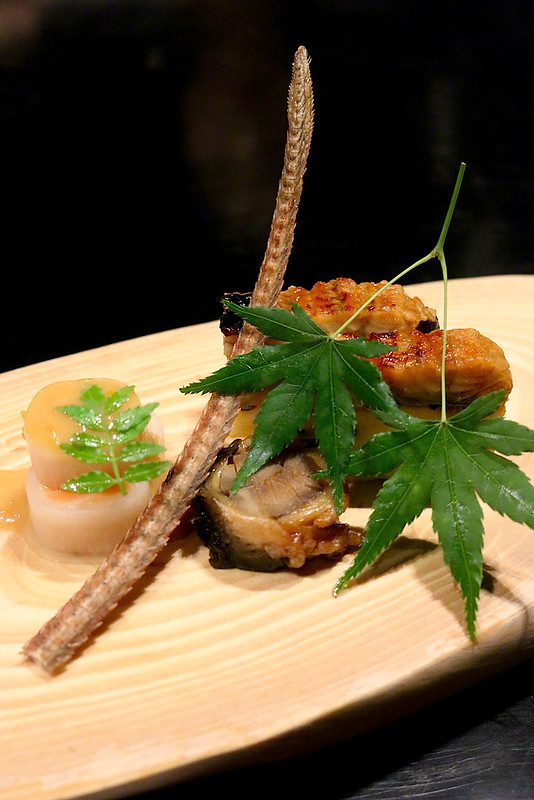
Mikuni at Fairmont Singapore is one of my favourite Japanese restaurants. It never fails to impress with a skilful blend of strong traditional basics with creative modern touches and aesthetics.
Executive Chef Moon Kyung Soo has brought the summer unagi festival "Doyo no Ushi no Hi" that's celebrated in Japan to Singapore. I'll have more on the festival at the end of the post. Eel is most fatty and nutritious during this time. Two menus - lunch and dinner - feature an amazing array of traditionally cooked eel dishes. This promotion runs 20 July to 7 August 2015.
UPDATE 4 Aug: Due to popular demand, the promotion has been extended to 31 August!
Both menus start with the Chef's Seasonal Selection (above) - three kinds of Zensai: Barbecued Eel Jelly, Smoked Salmon Yuzu, Eel Yahata Maki Burdock, Crispy Eel Bone.
Each one of these deserves slow enjoyment and exploration. The eel jelly is like a savoury custard studded with mushrooms and topped with unagi. Yuzu makes the smoked salmon sing. The hardy burdock has been stewed just right. The eel bone is a deliciously crispy umami stick. We wouldn't need calcium pills if we ate these every day.
Mikuni Eel Special Summer Lunch (S$120)
The five-course lunch is a good deal considering that it's 200g bowl of good unagi plus sashimi that includes otoro and Hokkaido uni. The regular unagi bowl is already S$77 or so. It's plated in one tray, almost bento-like, to make things easier to eat for those who have a limited lunch hour.
The lunch items are also in the dinner menu, but the latter has almost double the dishes, and more premium items too.
Mikuni Eel Special Dinner Menu (S$220)
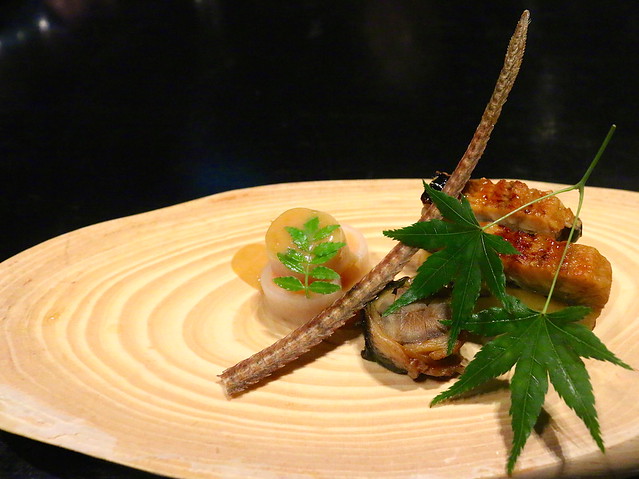
Chef's Seasonal Selection (above) - three kinds of Zensai: Barbecued Eel Jelly, Smoked Salmon Yuzu, Eel Yahata Maki Burdock, Crispy Eel Bone.
The eight course dinner starts with this elegant appetiser.
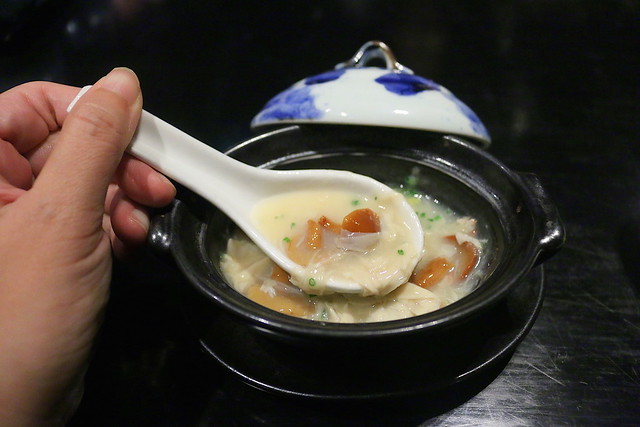
Fresh Beancurd Skin, Hokkaido Snow Crab, Mushroom, Yuzu
(Dinner only)
This innocuous little bowl at first resembles our beancurd skin dessert, but it is a potent brew of creamy seafood goodness. Warm, comforting and so very moreish.

Seasonal Sashimi: Hokkaido Sea Urchin, Aori Ika, Toro, Yellowtail, Sea Bream
Tastes as fresh and sweet as it is pretty.
Here's another look at that otoro...look at the fattiness of the tuna belly.
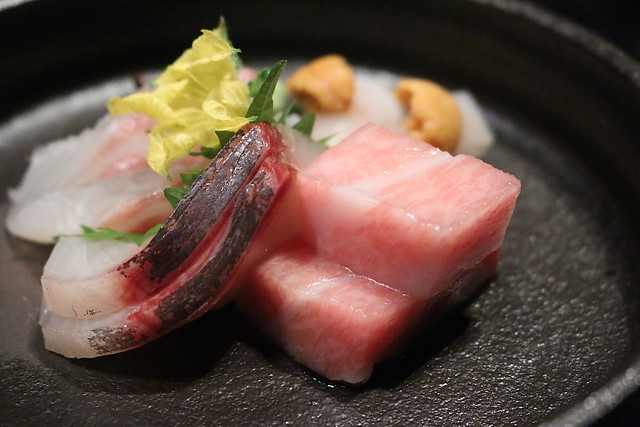
Grilled Salted Eel, Abalone, Mikuni Sauce, Wasabi, Daikon
(Dinner only)
Ah, this has the eel done shirayaki style (grilled with just salt, no basting sauce). It tastes a little bit more earthy. The huge abalone shell makes such a gorgeous container, especially with that metallic mizuhiki piece that often decorates kinpu envelopes. And I was very pleased to see the yamamomo (I finally know what this is called) - that berry that looks like a tiny lychee.
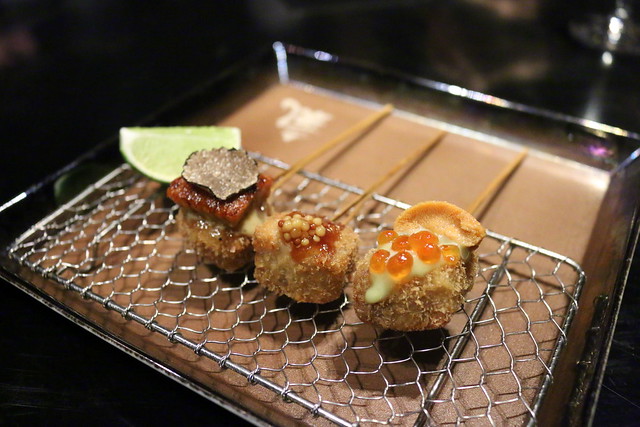
Kagoshima Wagyu Beef Kushikatsu, Black Truffle, Mustard Caviar
(Dinner only)
Some of you may be disappointed to see good wagyu done kushikatsu style but this was still fun to eat. This style of deep-frying panko-coated meat/vegetables is from Osaka. Here we have three large wagyu cubes with differen toppings.
- Black truffle with unagi
- Tonkatsu style with mustard caviar
- Wasabi mayo with ikura and uni
At the corner sits pink sakura salt in the Qi (Chinese) or Ki (Japanese) character.

Sunomono Moriawase
Eel, Scallop, Shrimp, Ginger Flower, Seaweed, Tomato
After the fatty course of deep-fried wagyu, we clean our palates with a vinegared medley of seafood and pickled vegetables (seaweed and cucumber at the back).
This refreshing combination of "unagi ja kyuri" (eel and cucumber) is sometimes called ujakyu for short. Do not think of yew char kway when you try to say that.
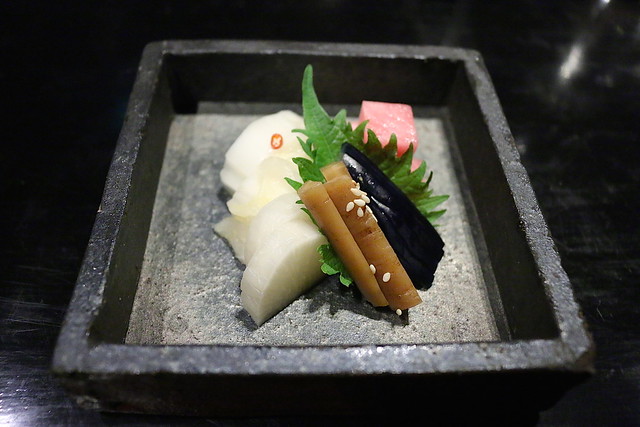
Mixed Japanese Pickles
This is to go with your unagi rice, which is this beauty...
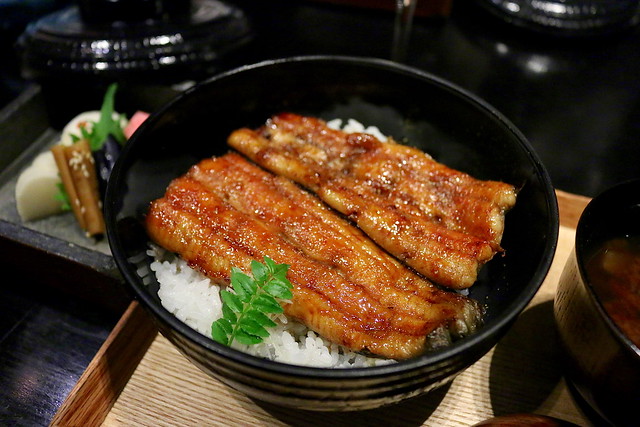
Charcoal Grilled Eel on Rice (Sumiyaki Unagi Donburi)
This was a hefty portion. The gently smoky eel is not drenched in sauce, and it isn't too sweet either. Everything down to the pearly beads of rice was so enjoyable. You do sense the fine bones here and there, but don't worry, it all goes down harmlessly.
A small bowl of Kyushu Shijimi Freshwater Clam Miso Soup accompanies the donburi and pickles. You can see it more clearly in the lunch array.

Kyushu Peach, Raspberry and Peach Ice Cream
Dessert is pleasantly light. We close with Japanese grown peach and ice cream.

If you like sake, top up S$90 for the sake pairing, which features these four labels.
Top left: Kikuhime B.Y. - nice, crisp and strong
Bottom left: Shinbun - wrapped in newsprint!
Top right: Ohmine Daiginjou - this one has "cow print" grading system;
one black patch is the highest grade, two and three are lower
Bottom right: Kamoshibito Kuheiji Betsu Atsurae - take note of this one,
as Mikuni booked the entire 2013 stock, so it's exclusive here. I can understand why; it's amazingly smooth and ethereal, and my favourite of the lot. |
Now we didn't just get to eat eel, we got to see and touch some too. It was eye-opening. Their skin is smooth with no scales, just a thick coat of protective slime. These eels have traveled six hours by plane from Japan.

Doyo no Ushi no Hi (土用の丑の日) is a day dedicated to eating eel. It varies from year to year, depending on the changing of the seasons. No, the name does not mean Eel Eating Day. Actually it's "The Midsummer Day of the Ox"!
Here's how it goes. The Japanese observe 18 days between seasons, called Doyo (土用). The period between summer and autumn - the 18 midsummer days - are the hottest time of the year (typically in July-August).
And in olden Japan, days (日) are named after the 12 zodiac animals - rooster, tiger, ox, etc.
So on the Day of the Ox (丑 or Ushi), people believed it was beneficial to eat things similarly starting with the letter "U" like udon, umeboshi, and naturally - unagi. But for unagi, it's not just a linguistic superstition. The midsummer days are also when the eels carry the most nutrients and fat. If you eat this in summer, you'll reap the vitality gained all through winter.
Eels are packed with protein, calcium, and vitamins A, B1, B2, D, and particularly E (can we say "E is for Eel"?).
There's another tale that says a shop vendor found that eels roasted on day of the Ox were the most delicious. So many fascinating stories.
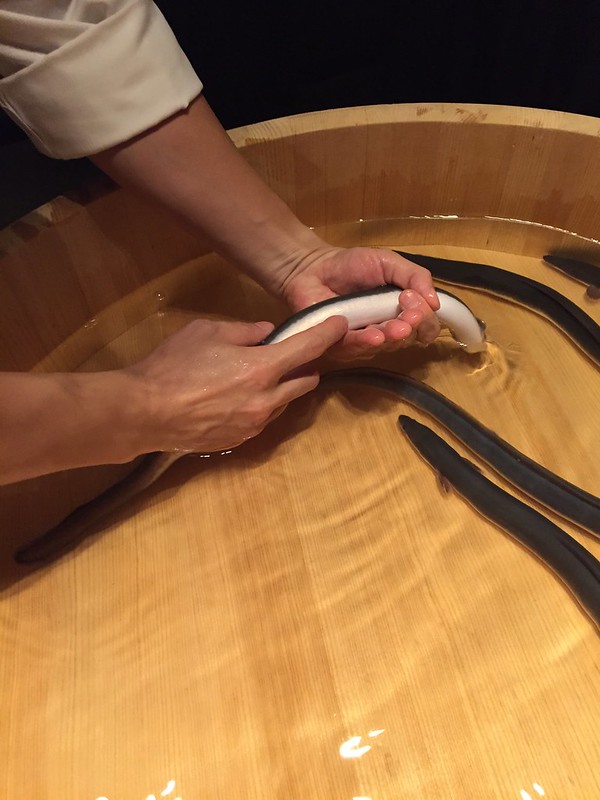
I think Chef said unagi (freshwater eel) are slit from the back, whereas anago (sea eel) is slit from the belly. I also read that when the practice of slitting from the back is largely done in Tokyo. It goes back to the days when Tokyo was still Edo (seat of the Shogun's power). Samurai used to converge there, and you know how they are with seppuku (ritual disembowelment). Out of consideration for these samurai customers, the unagi vendors refrained from slitting the unagi from the belly.
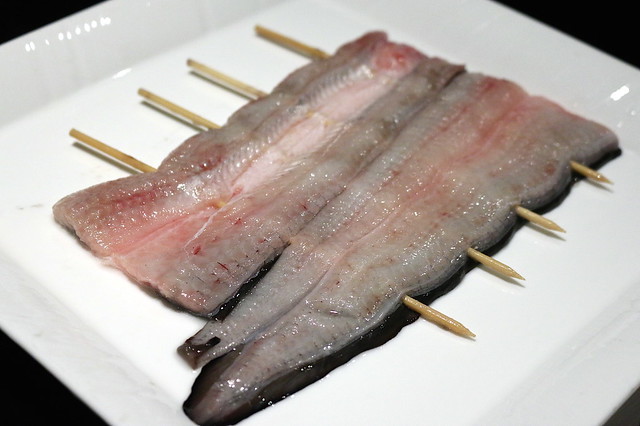
This is the unagi before it is cooked. This is slit from the back. See the white belly in the middle? It sure takes skill to be able to fillet the eel. They choose eels of a certain size, not too large, so that the bones are all edible after cooking. Chef Moon does it Tokyo style - steamed and charcoal-grilled. Folks in Kansai (western side of Japan) just grill it without steaming (apparently more chewy as steaming softens the meat). Next time I visit Japan, I must do this unagi comparison.
Chef Moon also gave us another tip. If an eatery tells you the eel is from Japan, check for the skewer holes at the sides of the fillet. Skewers are needed to keep the meat from curling while grilling. But if the fillet does not have skewer hole marks, it's been cooked in a Salamander, meaning it's pre-cooked eel likely from Thailand or China.
I always learn something fascinating when I come to Mikuni.
Check out my other posts for a tour of the multi-disciplined restaurant, and aspects of sushi preparation:
http://www.camemberu.com/2012/02/winter-robata-at-mikuni-japanese.html
http://www.camemberu.com/2013/04/mikuni-beautiful-food-and-priceless.html
If you have the FAR card, you'll be glad to know the benefits (e.g. 50% off for party of two) is also valid for this summer unagi festival!
MIKUNI JAPANESE RESTAURANT
Level 3, Fairmont Singapore
80 Bras Basah Road
Singapore 189650
Tel: +65 6431-6156
Open daily
Lunch: 12:00pm to 2:30pm (Last Order 2.15pm)
Dinner: 6:30pm to 10:30pm (Last Order 10.15pm)
Dress Code: Smart Casual
My warmest thanks to Chef Moon and the Fairmont Singapore team for the invitation and hospitality


The unagi is classed an endangered species from extinction due to extensive farming from caught frys. No known methods are available for farming from eggs stage since the unagi lives in fresh water lakes of and water ways of Japan and swims 3,000 kms to Guam to lay their eggs. Then the hatched frys swim back the 3,000 kms from where their mothers came but are caught and sold to unagi farms where they grow from 40mm to 200 to 250mm lngths. This is unsustainable and measures are in place to limit the farming practice plus those wild caught adults that are on the way to lay eggs. Unagi prices have hence skyrocketed.
ReplyDeleteThanks, I did not know that. You're right - BBC: Eels are endangered now!
DeleteI guess we shouldn't eat unagi as often as we should. In the past it was a dish for special occasions. What I really dread is how much places like supermarkets are using (and possibly dumping) this endangered creature now.
As the unagi is an endangered species I decided to expand some time to cultivate fresh water namazu or catfish which haas flesh that taste like unagi with similar texture. This may help mitigate the extinction of unagi as Asia is growing and the liking for delicious Japanese cuisine like unagi will accelerate its extinction.
ReplyDelete